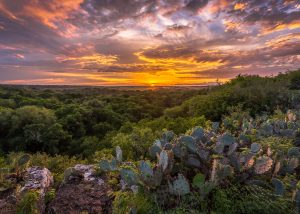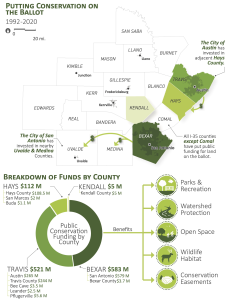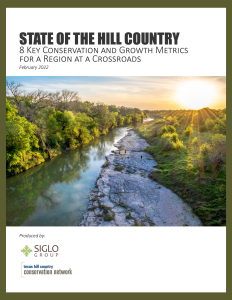Editorial by Commissioner Lon Shell, Hays County
As our population surges, will the Hill Country retain its character? I believe it can, however it is a challenge that will require unique and creative approaches to balance that growth with preservation of the very things that drive it.
We live in a remarkable place with beautiful resources, wonderful people, and amazing opportunities. People want to live here. They want to experience the quality of life that our region provides. They want to swim in the rivers and creeks, take in the views from the hilltops, and breathe clean air—and at the same time, have access to good jobs, affordable homes, low taxes, and a safe place to raise families. Unfortunately, without careful attention, this growth will negatively affect all the things we cherish and that drew us to this region in the first place.
 Editorial Series: State of the Hill Country Report
Editorial Series: State of the Hill Country Report
Over the next eight weeks, members of the Network are diving in deep on each metric to show how they apply to individual Hill Country communities. All of the following editorials are available for republishing, with credit to authors and the Texas Hill Country Conservation Network. Click to learn more.
In the recently published State of the Hill Country report, we can see a significant percentage of this growth is occurring in the unincorporated areas of the Hill Country counties. These areas are represented by County Judges and County Commissioners that have little to no authority related to land use. A rock quarry can be established next to an existing neighborhood. A new subdivision with hundreds of homes can be built off a narrow, rural road with no shoulders or turn lanes.
Rarely a day goes by that I don’t have conversations with concerned residents related to land use and its impact on their lives. Through these discussions most folks understand property rights and the importance of protecting them, and only ask that counties be granted reasonable opportunities to protect their way of life and the safety of their communities.

The sunset paints skies pink over a scenic view of the undeveloped Hill Country, taken in San Marcos. Photo courtesy of Jordan Moore.
Rapid growth affects our community in many ways from stressing our transportation system to depleting our water resources. Growth requires costly and constant attention because road building is expensive, and all lives depend on water. The burden of this cost is carried by our citizens.
We realize residential growth alone will likely not support the level of revenue required to manage it, so the local taxpayer is continuously strained as they are asked to pay for what others have likely caused. It is not that current residents don’t want to be welcoming, they just want to make sure their investment and quality of life are protected so that future generations may experience the Hill Country they have grown to love.
So, what can be done? First, we must recognize that residents of the Hill Country are resilient and eager to work on solutions. We should encourage constructive dialogue with local and state representatives on what types of local authority can protect our property rights and the character of this special place. I believe we can find reasonable and responsible ways in which counties can allow their citizens to have more of a say in addressing what happens in their community. That, after all, is the purpose of representing them in the first place.
Second, let’s share our success stories and build on the momentum. Our residents understand that transportation infrastructure improvements and flood mitigation projects must be made but ask also that we invest in preservation of our natural resources.

This map – taken from the 2022 State of the Hill Country Report – shows Hill Country counties that have invested in conservation through public ballot initiatives. Click to learn more.
In 2020, Hays County voters approved a $75 million-dollar investment in parks and open space with 70% approval. This is in addition to approving bond packages of $3.5 million in 2001 and $30 million in 2007. Many of the projects included in these bond initiatives focused on land conservation.
These public investments can help offset the ever-growing impacts related to development. Conservation projects can help protect water quality, mitigate flood risks, preserve wildlife habitat, as well as provide public recreation opportunities and preserve rural lands that will help maintain the character of the Hill Country. When residents support investments in conservation like they have in Hays County, it becomes a model and motivation for others in the region to build similar support.
Third, we must leverage investments in conservation. Our citizens deserve to see their money not only used for public benefit but used efficiently. We have seen that sometimes relatively small investments can be used to produce large results. Collaboration with regional partners can lead to innovative uses of current funds, like the Texas Water Development Board’s Clean Water State Revolving Fund for land acquisition related to water quality protection and flood mitigation. The proper use of these funds can help offset future costs for expensive infrastructure projects while at the same time preserving open spaces.
Finally, if growth is inevitable, we must strive to provide homes for future residents in a way that respects those that are here now and those that came before us. This means working with those investing in our region and finding creative ways to include and incentivize our community’s conservation goals.
Hays County is now working on the creation of guidelines and rules for conservation-minded development. I believe we can provide a balance to growth by working with the development community on ways to lessen the adverse impacts of their activities by conserving portions of land that otherwise would be developed. The resulting neighborhoods will not only be recognized as models for responsible development, but they will also be valued and enjoyed by those that choose to live there.
Whether we have been here for generations or only a short time, we are all shareholders in the Hill Country. We have the responsibility to ensure our investment here is not only in our home or the property which we own, but we must also invest in protecting the character of the Hill Country as we make room for others to enjoy it.
Media Contacts:
John Rooney, Texas Hill Country Conservation Network | 717-578-6276 | john@hillcountryalliance.org
Leah Cuddeback, Hill Country Alliance | 618-979-5223 | leah@hillcountryalliance.org
Click here to access and download the full press release.
About the Author
Lon Shell has served as a Hays County Commissioner since 2017. In that role he has been an active voice for land conservation, the need for more groundwater science, protecting the county’s natural resources, and supporting trails and public parks for people.


